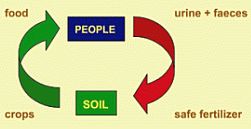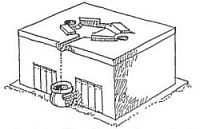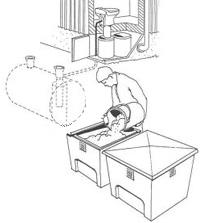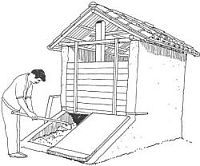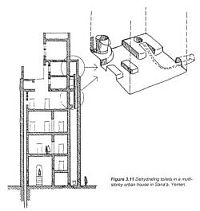|
|
|
| Table of Contents |
| 1. Another eco-shift in paradigm |
|
You may say, well, what the heck are you talking about? You may say we have already found the problem and he/she is us, referring to the fact that many diseases are borne in our intestinal tract. In fact, this has been well established since the time that the cholera epidemics in London in the 1800's were finally linked to the city's plumbing by the scientist John Snow (Okun, 1996). But the main problem with the belief that our waste products are bad is that this philosophy itself is flawed. It is bad because it is an inaccurate portrayal of the actual situation. It is the niche of many species of microbes to take out nutrients from our waste stream for their own survival. These materials can be any organic substance. What may smell bad to us may lure these organisms. The problem though, is with the pathogens found in the waste material. The problem is not the inert material itself. When the material is taken up by microorganisms, the pathogens go with them. In order for a shift to an ecological "no-flush" society to occur, we must accept the goodness of our excrement. Or at least accept the fact that our body's ability to absorb all available nutrients from our food is not 100%. This residual can and will be eventually returned to the environment. However, the choice of the pathway, by which the return will take place, is up to us. Will we put it in water, then clean the water and put the water back in the river and put the solids in landfills? Or will we dry it out and then maybe compost it and then put it directly on soil as humic materials? These are some of our choices, and it is a decision that many of us never realized we had accepted. It is the purpose of this article to explain one of these alternatives to the general public so that they can make their own informed decisions. Over the past several decades, there has been a grass-roots effort in the United States to propagate the utility of not flushing the toilet and recycling its useful materials. This can be done in many different types of settings. There are basically two types of "no-flush" toilets: composting toilets and dry ecological latrines. In composting toilets the key is for microbiology to take over and to break down the material eating the pathogens and excreting inerts. These inert residuals will convert into humus, a soil fertilizer, over time. In dry ecological latrines a different mechanism takes over. Desiccation is the process of drying up or evaporating water from a material. In arid climates, physical methods (i.e. desiccation) can be more efficient (less energy consumptive) at killing pathogens than other "biodegradative" methods. There are five points which must be stressed in assessing any system of sanitation. This was well stated by the researchers involved in the Swedish International Development Cooperation Agency (SIDA), who have published an authoritative text on this subject, entitled Ecological Sanitation. These five criteria, essential to a complete evaluation of a sanitation system, are:
To view the differences in the flush sanitation system and the drop-and-store system, as put together in Ecological Sanitation, click here. Throughout this article we will refer back to this reference many times because, from our research of the literature, it seems as though this group is in the forefront of this technology. Another key point involved in transforming our thoughts on sanitation is that we must enlighten ourselves to a holistic approach of evaluation. There are four critical elements involved in sanitation. Nature forces the direction of the inevitable processes involved in redistributing our waste back to the soil. Cultural settlement patterns can be (a) concentrated or dispersed, (b) concentrated in low or high-rise shelters, (c) can have attitudes of fecophobia or fecophilia, and (d) can have habits of washing or wiping. Also, there are many associated beliefs and taboos related to human excreta and the economic status of the community. Geological, physical, chemical, and biological processes affect human excreta, and will eventually transform it into a safe, inoffensive, and useful product. The actual device used for defecation and urination must be properly designed, constructed, and maintained.
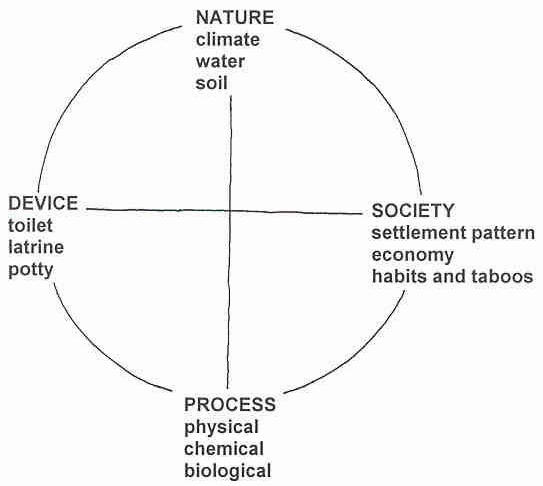
society, process and device. All these components must be considered together. Diarrheal dehydration claims the lives of nearly 2 million children every year. According to UNICEF (Sanitation Connection), diarrheal dehydration has killed more children in the last ten years than all the people lost to armed conflicts since World War II. What should we be afraid of? We should be afraid of infectious diseases that are transferred from person to person by means of our waste products. The following table gives an example of the burden that disease can present to people and what should be done to resolve these pressing issues.
Notes:
The remainder of this paper will discuss the problems of waste products in more detail. The Dry Ecological Sanitation solution to this problem will be presented. The no-flush system may be just as effective as the flush-toilet system at protecting public health. This article will describe a number of studies that have been preformed on these methods. The article will include a table of the various types of products that can be fabricated under the ecological sanitation, or ecosan, methodology, in an effort to convey the universality of this alternative sanitary system. It is hoped that this alternative will gain more exposure through this webpage. | ||||||||||||||||||||||||||||||||||||||||||||||||||||||||||||||||||||||||
| 2. The importance of public health |
| It is important to have a grasp of the microbiology in our waste stream if we are to adequately judge the capacity of implementing any novel sanitation system. We must realize that our wastes contain many forms of microorganisms, varying from fully grown bacteria to worm eggs (when one is infected) and cysts of numerous other organisms. The organisms causing disease are called pathogens. Those which live in, at, or on another organism are parasites. A majority of these bugs excreted from humans are found in the fecal waste stream. Aside from the malodor, urine is typically thought to be sterile, posing few threats to our well being. Sometimes though, diseases are passed via the urine route, most notably of these, is the bilharzia parasite. Fresh feces are the substantial source of many pathogens such as typhoid and paratyphoid which threaten the world's water supplies. An infection is defined as the invasion and growth of microbes in the body. An infection may or may not cause damage or disruption of physiologic processes. A disease is a condition in which certain physiologic processes are not functioning properly. Most diseases result from an infection of pathogenic or opportunistic microbes, although they may also result from an imbalance of hormones, genetic defects, and nutritional deficiencies (Lankford, 1979). There are four processes involved in infection and disease (Lankford, 1979).
There are several routes by which a human can communicate a disease to another, these are(Lankford, 1979):
Microorganisms in the body can cause problems such as poor growth (in early human development), iron deficiency, vitamin A deficiency, and other micronutrient deficiencies. Obviously, when another organism is trying to sustain its vital processes within a human, the human will loose some nutrients in the process. All bugs are not bad. Many help us accomplish our daily functions in a more efficient manner. These dependents, or pseudo-dependents, are known as symbionts. These symbiotic pathogens and parasites are not always the primary cause of death; however, their presence aids other types of disease by weakening immune systems. Debilitation and malnutrition predisposes people to continual disease and ill-health and eventual death. According to C.Schonning & Thor A. Stenstrom : In the bladder, urine is sterile and there are less than 10,000 bacteria/mL in freshly excreted urine. Urinary tract infections are not transmitted through the environment. There is a low risk for transmission of infectious diseases through urine. The biggest contamination problem comes from fecal cross-contamination of the urine. Bacteria and viruses are immediately infectious after excretion. Protozoa are excreted primarily as cysts, and become immediately infective or require a detention period outside the body before becoming infectious. Helminth (worm) eggs, many of which are resistant to environmental conditions, require a period outside the body before hatching. Some parasites, such as bilharzia, require an intermediate host before becoming infectious. To read more on different types of worms that can invade a human, click here. Four groups of organisms found in fresh feces are threats to humans:
In fact, one gram of feces can contain an estimated 10,000,000 viruses, 1,000,000 bacteria, 1,000 parasite cysts, and 100 parasite eggs (Sanitation Connection). Jac Wilsenach, of the Netherlands, says: "Between 150 and 200 litres of combined rain-, grey- and black water is treated daily for each person. The contribution of urine to this volume is less than 2 litres. Among other minerals, our daily urine production contains 11 g of nitrogen (N) and 1 g of phosphorus (P) per person. This means that 70 to 80% of the N load and 40 to 50 % P load in municipal wastewater originates from less than 1% of the total volume of water treated (Wilsenach). Grey water refers to waters used for activities like dishwashing, laundry, and bathing. Black water, here, refers to flush water. When a person excretes a pathogen which is not contained or destroyed, the environment becomes contaminated. Once human released pathogens gain access to the larger environment (see Figure 2.1), they can contaminate fingers (hands, clothes and utensils), fluids (e.g. drinking and cooking water, beverages and other water bodies), fields (vegetables and household yards) and flies (e.g. houseflies and blowflies, domestic animals and snails), Ecological Sanitation.
 contaminating fingers, flies, fields, food and fluids and then eventually swallowed.
People may be exposed to pathogens and parasites directly through these routes or via food. A contaminated environment puts people at risk of exposure to pathogens, leading to infection and disease. Newly infected people then excrete into the environment and there is a repeated cycle of infection, contamination and infection. The spread of pathogens can be reduced or stopped by using "the multiple barrier technique," just as in the flushing-society's wastewater treatment schemes (e.g., reduction of settleable solids followed by removal of nonsettelable solids, followed by additional physical/chemical unit operations are commonly denoted as primary, secondary, and tertiary techniques). In our case, a primary barrier would prevent feces from reaching fingers, flies, fluids, and foods. However, if pathogens gain access to fingers, foods, and so on, secondary barriers (e.g. washing hands, cooking food) must be relied upon to prevent exposure. The overwhelming argument is that a dry system based on eco-san principles developed by the SIDA group (Ecological Sanitation) can provide an effective primary barrier (see Figure 2.2).
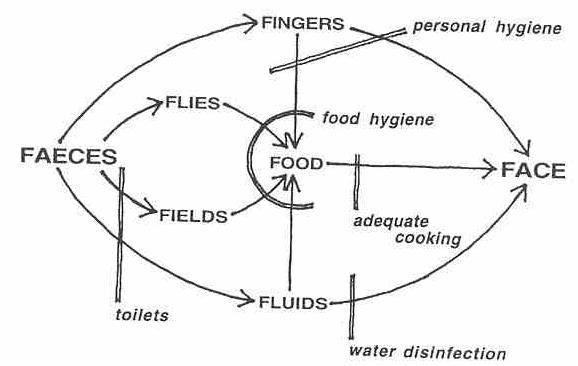
In the flush-and-discharge system, sewage is adequately treated to regulatory standards and made safe before being discharged. In most places around the world, it is discharged totally untreated, or only partly treated. Either way, the pollution problem will spread downstream, be that in the raw form or as treated effluent with carcinogens added as part of the disinfection technique. Another method to control ourselves from the cycle of infection and reinfection is to treat people with disease. For this, modern medicine is called upon to protect the population. A child with diarrhea can be given an oral rehydration solution (ORS) or an antibiotic. This disease will usually be cured. Yet, the true culprit will still be on the loose as the pathogens will continue to be excreted from the infected individual. A harmful outbreak of cryptosporidiosis occurred in Milwaukee, WI a few years ago, resulting in numerous deaths in the local community (Okun, 1996). Also, the rapid evolution of drug-resistant strains of infectious diseases underscores the importance of prevention rather than treatment. This is in opposition to the old adage that "if it ain't broke, don't fix it." It appears that our system may be broken. The bugs are finding cracks in our current protective barriers and our infrastructure continues to erode. We must either choose to keep pace with the evolving bugs, or to cut them off from our waters. A dry ecological latrine system proposes to keep microorganisms in the dirt.
|
| 3. Origin of the dry ecological latrine |
|
Regions in India and Yemen have been practicing forms of dehydrating sanitation for many centuries. This practice is the accepted norm and has appeared to work well. For many reasons, Western culture has decided to do its business in very different ways from Eastern cultures. And just as in most any other aspects of life, westerners decided to endorse the flush-and-discharge practice, following the popular NIMBY (Not In My Back Yard) philosophy. The dry ecological latrine, as we know it today, has evolved in the humid climate of Viet Nam. The dry latrine has flourished as an inexpensive and effective solution to sanitation in so-called "developing countries" (Charity Wire). In Viet Nam, only 17% of households have some kind of latrine. As a result, the incidence of parasitic disease infection is 60 to 80%, and cases of diarrhea are 1240 per 100,000 people per year. Viet Nam has a long dry season, lasting about 8 months, and a rainy monsoon season. Since 1956, the people of Viet Nam have built double-vault latrines. By 1985, other sanitation schemes, such as pour-flush systems and septic tanks had been introduced. With such bad public health problems, several local environmental groups have become increasingly skeptical of the hygiene of the double-vault latrine systems (Bui, et al.). However, those involved with SIDA projects in the region believe that the poor health situation has more to do with the miseducation of the people and the mismanagement of partially dehydrated wastes, rather than with the system being incapable of killing all pathogens. |
| 4. Case studies |
Santa Cruz, BoliviaThe Mennonite Central Committee (MCC) has worked with the government of Bolivia to provide materials and disseminate information about dry-latrine technology. In 1999, the MCC produced such an effective demonstration for the Bolivian rural sanitation ministry (PROSABAR), that they funded the construction of 385 units north of Santa Cruz. These units cost $65 for labor and brick compartments. The community provided roofing material and some extra labor. These units were above ground and included a separation of urine from feces (Charity Wire). Peter Morgan has concluded, based on a study by Moe et al. (2001) on urine diversion systems, that the safety of the end product may be linked to the extent to which recommended management techniques are followed. Also, if hand washing facilities are not available near to the toilet, soiled hands can easily contaminate such objects as door or cover plate handles, towels and other objects. Thus, the toilet itself may not necessarily be directly implicated as the pathogen vector device.
Cam Duc, Viet NamIn a binational study (Bui et al.) involving Sweden and Viet Nam, the urine-diverting ecological sanitation (eco-san) scheme was closely monitored for its effectiveness in the reduction of pathogen retention times. The study was conducted in the small farming commune of Cam Duc in the Cam Ranh District, Khanh Hoa Province. This commune includes 9,940 people living in 1,831 homes. The percent of the population infected with intestinal parasites is 65%, and the incidence of diarrhea is 1,100 cases per 100,000 per year. The study consisted of monitoring 12 latrines over the pathogen life-cycle period. The six different types of latrines (2 of each type) monitored were:
Click here for a description of the analytical methods. Moisture was shown to be lowered faster in toilets with heaters. Moisture ranged from 25.4% to 58.5% with a median value of 34.9% (see Table 3.1 below). Outdoor ambient air temperatures averaged 32.4°C. In-vault ambient air temperatures averaged 34.7°C, while the fecal-decomposing-material averaged 33.9°C.
The pH of fecal-decomposing-material was strongly related to the type of ash cover added to the pile post-defecation. The average quantity of ash addition was from 100 to 300 mL. The pH of wood ash was 11.3 and found to be most effective in pathogen reduction. At a critical probability of 0.05, the only statistically significant variable was pH. The days until Salmonella typhymurium phages die-off was somewhat shorter than that of Ascaris suum eggs. These ranged from 44 to 154 days for Salmonella typhymurium phages, and from 51 to 169 days for A. suum eggs. Click here for the results. The findings of this study point to several significant clues to the use of dry ecological latrines in developing countries:
Juarez, MexicoA group of researchers from the University of Texas at El Paso installed dry ecological latrines in the vicinity of Juarez, Mexico. They performed two rounds of studies, the first centered on fecal coliform counts in relation to the EPA's classification of biosolid wastes. The second study added on the initial findings and studied a sect of the populace with dry latrines to try to find the causal relationships between socio-economic status, age of children in households and crowding of households as related to quantities of disease-transmitting microorganisms. The first study evaluated the usage of 90 prefabricated, dry-composting toilets (Sistema Integral de Reciclamiento de Deschos Oragánicos [SIRDOs]). Samples were evaluated at 3 and 6 month periods of toilet usage. The quantity of samples reaching the EPA's Class A ranking rose from 19.4% for the 3-month incubation period to 35.8% in the 6-month samples. This demonstrated the fact that longer periods of desiccation increase fecal coliform kills. It is of note that there was excellent management of the toilets in this study. 89% of users used paper and 96% used sawdust as a soak material for the composting pile. SIDA had shown that the ideal C:N ratio for composting toilets is between 15:1 and 30:1. Another study presented the case that human excreta have a C:N ratio of 5:1. The carbonaceous material is boosted by use of "bulking materials" like paper and sawdust, which are rich in carbon. Another good benefit of this sanitation scheme was that 64.5% of units did not produce a detectable odor. While only 4 samples met the Class A criteria, 54% had moisture contents less than 40%. There was a significant correlation (P=0.008) between classification rating and percent moisture for the biosolid samples. This means that desiccation has a great effect on the reduction of fecal coliform counts. It is likely that aerobic biodegradation was not a factor since the composting piles were not regularly turned. Stirring generally encourages aerobic microbe growth by alleviating the outer surface restriction of air (O2) passage into the depths of the pile. Since fecal coliforms are only indicator organisms, other pathogens needed to be used to evaluate the effectiveness of these toilets at protecting public health. The findings of the second study turned out contrary to logic, as the crowding factor (which they assumed equal to the number of household members per room) was inversely related to the prevalence of Giardia. The USEPA's classification scheme is simply broken down as follows: Class A Compost consists of less than 1000 MPN fecal coliforms/gram. Therefore they found that the composting toilets produced only 36% Class A Compost. Typical methods of disposal include either burying or bagging. The bags are generally hauled off with household refuse and buried in a landfill, incinerated, etc. So, the pathogen vectors are tied to who cleans out the latrines and disposes of the desiccated materials. This is exactly where sanitation in the form of a hand washing station should be located in the vicinity just outside of the latrine station. The following diagram shows the differences in the relationship of total coliform, fecal coliform, and e. coli. to the occurrence of sickness. It plainly demonstrates that both total coliform and fecal coliform counts are both related to sickness in a very undeterminable way. On the other hand, e. coli. counts show a distinctly linear relationship with the onset of sickness in humans.
 Description of total coliform from fecal coliform from e.coli.
PalestineIn another SIDA-funded study, ecological sanitation was initiated in the Palestinan Occupied Territories of the West Bank, near Hebron. The site was evaluated to be a good study area due to the aridity of the region and the current socio-economic conditions of a majority of its inhabitants. It was duly noted that this project could have had greater success if the Israeli leaders had not started the second intifada in September of 2000. This policy resulted in 70 to 90% of the Palestinian community being unemployed as well as increasing the price of imported water (via water tankers) by 80%. The project was beginning in March of that same year. This created a social uneasiness that led many people who may have previously considered making such a switch to decide not to buy anything that could in less than a day end up as a pile of rubble. However, this does nothing to change the region's climate. Thus, the likelihood of future success of dry ecological latrines is still a viable possibility. 80% of rain that falls on the West Bank (on average 350-450 mm/yr - varying from 0 to 1000 mm in any given year) is appropriated by Israel. Municipal piped water systems provide only 45% of the Palestinian demand. Only 30% of the Palestinian population in the area is connected to sewerage networks. Most of these networks discharge into wadies and open land without treatment. These discharges could seep through cracks in the rock structure underlying the discharge zones and end up as a pathogen vector in the area's groundwater resources. Due to time restraints, the researchers visited only 20 of 28 households that were using ecotoilets. These ecotoilets were built with a squatting pan for urine diversion, a short chute (200 mm diameter), a lid, a drain for water used in anal cleaning, a urinal, a washbasin, and a processing chamber below the floor with an access door and vent pipe. The units included a container for toilet paper and bucket for lime/ash, and two to three 80-liter vessels for the feces and a 20-liter vessel for the urine. The units have been added within households and as a separate attachment. The ceramic squatting pans were made at a local workshop in the West Bank, and are similar to those used in China. The processing chamber is 1 x 2 m wide and 0.6 to 0.8 m tall, built of brick and plaster. They contain a sheet-metal access door and a 100-mm vent pipe extending above the roof. The special lids to collect and divert waste water from anal cleaning is a new idea, but believed to not be as effective as originally planned (see picture below). Another important point learned from talking with the users was that vent pipes that were located on the colder side of the building were not as effective in preventing odor emanation. In the future, vent pipes should be located on the sunny side (morning sun) of the building so that the air in the pipe will be warmed, rise and thus create a downdraft through the drophole.
 As far as operation and maintenance is concerned, the main suspect of trouble, the water used for anal cleaning, ended up causing no major problems. Some households dumped urine and anal cleaning water into cesspits or septic tanks, while others used urine (with water dilutions) as fertilizer for tomato and olive crops. At the time of inspection, the first round of drying had not come to completion and, thus, a complete analysis of the effectiveness of dry ecological latrines could not be assessed. The authors referenced results from another report by Peter Morgan working in Zimbabwe where a 3:1 dilution of water to urine was used on crops with the following results:
Another comparison to the current state of government spending on public works for public health was the implementation of the sewers added to the Alfawar Refugee Camp which allowed the excreta from 5,000 people in the Camp to be diverted to a wadi 1 km away. The area has a lot of fractured rock and this is a pathway for pathogen transmission into the local aquifer. It was aptly stated by Uno Winblat's report that this "does not solve the problem - it is just relocating it." The following picture shows a modern bathroom with all the amenities. At a closer glance, one will notice that it, in fact, includes the advanced technologies of dry ecological sanitation.
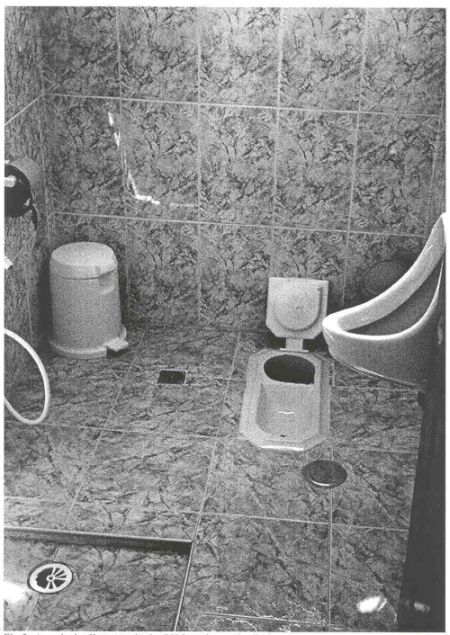
Guangxi, ChinaChina has reused human excreta for over 2000 years. However, Western documentation of their success is very sparse, dating back to one of the first sustainable agriculture texts: Farmers of Forty Centuries or Permanent Agriculture In China, Korea and Japan, published in 1911 by King. In 1993, a survey showed that 94% of human excreta were used in agriculture, although only 13% were sanitary. According to Pan Shunchan of the China Academy of Preventive Medicine, dysentery, typhoid fever and other diarrheal diseases are the cause of 70% of infectious diseases in China. 531 million people are infected with roundworm, 194 million with hookworm, 212 million with whipworm and 870,000 with schistosomiasis.
This is a testament to the widespread misunderstanding about the necessity of the cleansing of human waste prior to land applications. China's large population makes the control of pathogens a necessity. With the proper education about ecological sanitation, public health will improve. Starting in 1987, the Chinese Ministry of Health began instituting increased hygienic standards for the disposal of excreta. It is estimated that the level of hygienic disposal has since increased from 7.5% to 45%. SIDA and UNICEF began funding projects in Guangxi province in 1998. Fiberglass squatting pan, two-compartment toilets were provided to the county of Yongning. School units included pedal-operated ash-dispensers. By 2000, 45 villages began to use dry latrine technology with plans to extend the program to 170 villages by the end of the year. By 2001, some 24,500 ecosan toilets had been installed (1st Int'l conference, 2001).
| ||||||||||||||||||||||||||||||||||||||||||||||||||||||||||||||||||||||||||||
| 5. The components of our waste |
|
The need for sanitation has been explained and several case studies have been examined. Dry latrines reduce the risk of disease transmittal by destroying the pathways of pathogen transport. On the other hand, in developed countries, current practice is to use water to carry waste to the treatment location, process it and then dispose of it. Regardless of the chosen method, there is always an effluent that some habitat will have to diffuse into the environment. Since early times, human waste has been recycled into the soil. There is a substantial amount of research on the use of septic tank effluent and recycled water. In addition, there has been some research on the use of fecal matter on soils for farming (the so-called "nightsoil"), and urine as a natural additive for increasing crop yields. The characteristics of urine are shown in Table 5.1.
A Swedish study (Jönsson, et al.) stated that urine can be added as a nitrogen amendment for agriculture, with fewer heavy minerals than typical fertilizers. In their study, several double-flush toilets were used (see Figure 5.1). The study inhabitants were found to produce 4.9 g of nitrogen and 0.42 g of phosphorus each day. Prior studies had shown nitrogen and phosphorus production to be 16% and 24% more than that recorded in this study.
 An important point in this study was the separation of waste materials, and thus, the decrease of fecal and subsequent pathogen risk factors in the urine portion available for soil addition. Soil addition was also recommended in dosages of 3 parts water to 1 part urine. Why is urine good for crops, cereal crops in particular? Urine contains the major load of human daily nitrogen excretion, and plants need nitrogen to operate and produce energy via the important biochemical reaction known as the Krebs cycle. The double-flush toilet refers to the mechanism by which both the urinal and fecal portions of the toilet are flushed with a minimal amount of water for self cleaning. This mechanism was calculated to have saved 48% of flush water compared to conventional water closets. What happens to urine after it is discharged from a human body? The following reaction occurs:
This chemical reaction is the transformation of urea, CO(NH2)2, to ammonium, NH4+, carbon dioxide, CO2, and free hydroxyl radicals, OH-. This is known as a dissociation process as the moisture in the air or soil, H2O, comes into contact with urine vapor, which contains urea (to see results from Jönsson, et al., click here). A controlled study conducted in a greenhouse in New Zealand (Williams and Haynes, 1997) looked at the addition of urine on a mixed cropping farming system, much like a prairie pasture. They labeled soil organic nitrogen with 15N in two types of patches, one amended with urine and one without. The results showed that 40% of the 15N, derived from grass/clover residue, turned up in wheat plants. Only 10% of the 15N was derived from previously immobilized urine additions to the soil and were recovered in wheat plants. Overall, 96 to 98% of nitrogen accumulated in wheat plants was found to originate from mineralized native soil organic matter, 14N. The study showed inconclusively, however, why the mineralized soil organic matter of the native soil appeared more abundantly than the liquidous-derived, presumably-available, pools of 15N labeled organic nitrogen. More research on this topic is needed to identify all the important reactions that take place in the soil. This could make the use of urine as a valuable crop amendment understood by the agricultural community. This endeavor will not be an easy task, as soil scientists know how difficult it is to monitor reactions within the soil horizon. As soils vary in their geochemical characteristics from region to region depending on natural history, urine applications should be understood from a holistic framework. | |||||||||||||||||||||||||||||||||||||||||||||||||||
| 6. Types of dry ecological latrines |
|
The use of latrines goes back many years, even centuries. This "latrinology," as we like to call it, was well documented by the SIDA group. The following table describes and compares the different types of latrines that have developed. For a more detailed comparison see Types of Ecological Dry Latrines.
|
| 7. Summary |
|
|
http://ponce.sdsu.edu/ecological_latrines1.html
|
110928
|
